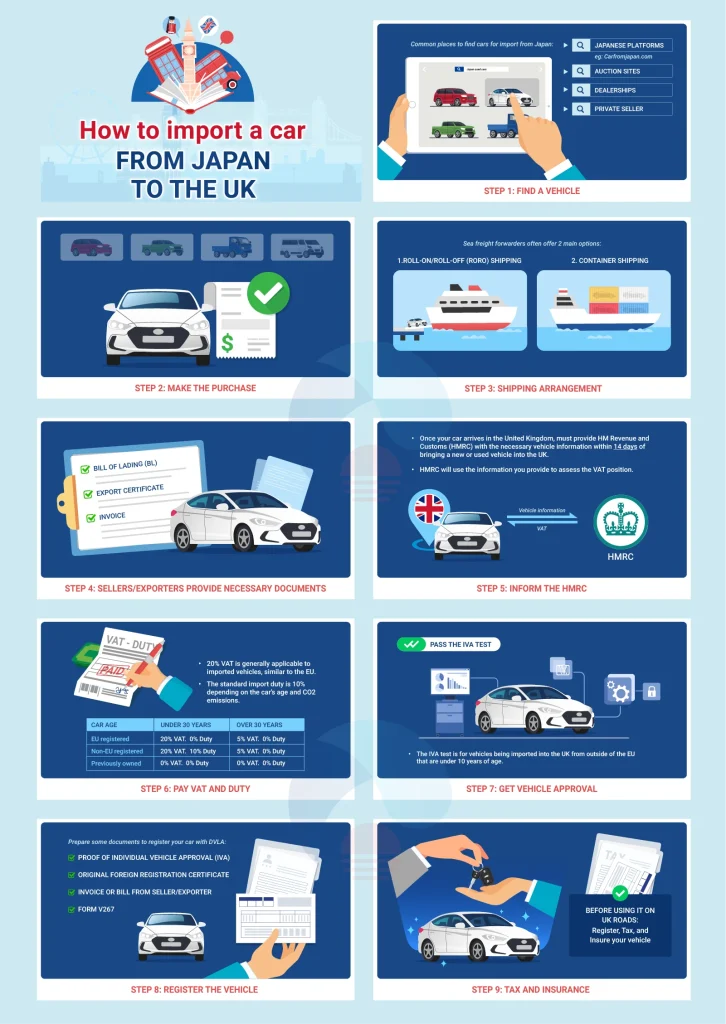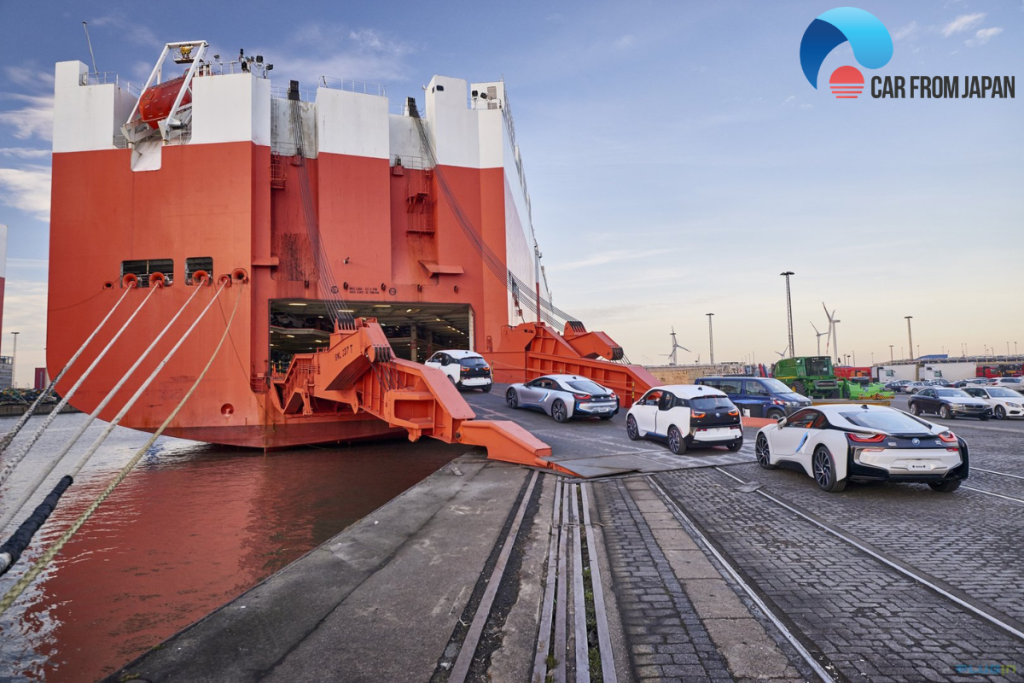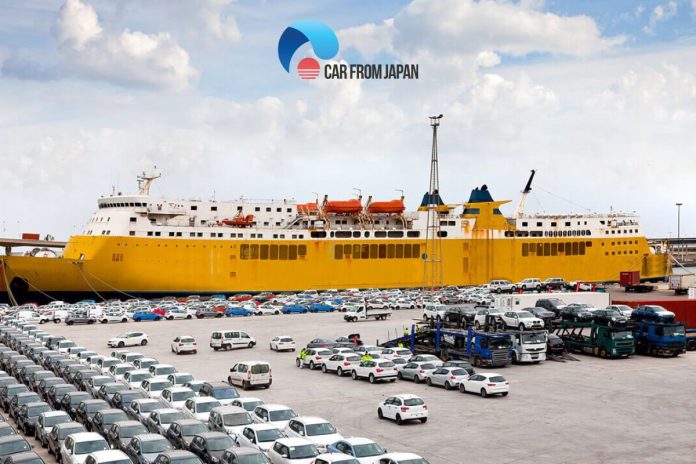Japan is one of the biggest suppliers of new and used cars worldwide. That’s a fact! From iconic sports cars to reliable Kei trucks or vans, Japan offers a diverse range of vehicles that capture the hearts of every enthusiast.
If you’re dreaming of buying a Japanese car directly from Japan and bringing it to the UK, we’ll cover the whole process of how to import a car from Japan to the UK from finding a perfect car, and registration to the costs involved. Don’t wait too long, let’s check out the whole importation process below:
Contents
- Can I Import and Register a Car from Japan to the UK?
- Pros and Cons of Importing Cars from Japan To The UK
- How To Import A Car From Japan To The UK
- How Much Does It Cost to Import a Car from Japan to the UK?
- How Long Does It Take to Import a Car from Japan to the UK?
- FAQs About Importing Cars from Japan to the UK
Can I Import and Register a Car from Japan to the UK?
Yes, you can import and register a car from Japan to the UK. However, you must follow specific regulations and certain steps to bring a vehicle permanently into the United Kingdom.
You can be fraught with issues or prosecuted when driving your imported car on the UK’s roads If you don’t know the rules and regulations involved. For example, the rules outlined in the Department for Transport’s INF106 document.
As part of the UK’s vehicle registration process, you must deal with different Department for Transport (DFT) agencies. Some steps and regulations will differ depending on how you bring the vehicle into the country and whether it is a new or used vehicle.
Pros and Cons of Importing Cars from Japan To The UK
Is importing a car from Japan a smart move compared to buying it directly in the UK? We will break down the pros and cons of importing cars from Japan to the UK below to help you make a decision:
Pros:
Wider selection
The attraction of Japanese imported cars lies in the wide variety of vehicles, including unique models not available in the UK market such as Nissan Silvia (S15), Autozam AZ-1, or Skyline GTR R34…
This will satisfy enthusiasts to have a legendary, classic, or highly sought-after vehicle. With a lot of available models, you can compare specs, prices, and conditions and find the best option for you.
Potentially lower price
Depending on the model and condition, importing a car from Japan can actually be cheaper than buying a car in the UK even with shipping/ insurance/import tax included in the price due to lower manufacturing costs and lower import duties. Favorable exchange rates and differences in car depreciation curves can help importers save big bucks
Better condition options
Japanese cars have long been regarded as some of the most dependable cars on the road. No doubt this is due to the stringent quality control checks they have to pass before they are allowed out of the automakers.
So, importing directly from Japan can ensure access to well-maintained vehicles with a strong reputation for durability.
Right-Hand Drive configuration
If you mainly drive in the UK, it’s better to have a right-hand drive car, and Japanese cars are outfitted as right-hand drive vehicles too. Yes, that means that you don’t need costly conversions for UK roads. This is a big plus point when it comes to importing a car.

Cons:
A complex and lengthy process
Importing a car sometimes can be a daunting task as it involves multiple steps from finding trusted exporters, and handling customs clearance to ensuring compliance with UK regulations. So if you buy a car in the UK there are no importation hassles.
Import fees and taxes
Taxes and customs duties are inevitable fees during the import process. Although they don’t cost much, these costs also contribute to the total price of the vehicle. In addition to these costs, in some cases, there will be incurred costs such as repair costs for unforeseen issues or delays in shipping.
No ability to inspect in person
This is another potential downside of importing a car, you can’t physically inspect the car (or take a test drive) before committing to purchase.
With all these pros and cons, the choice is yours!
How To Import A Car From Japan To The UK
The first thing you have to do is to study the used car importing laws and regulations of your country. Also, make sure that the exporting company removes the air conditioner’s gas and cleans the car of dirt, insects, and biohazard ingredients.
Common steps to import a car from Japan to the UK are likely to include:
Step 1: Find a vehicle
Where to find Japanese cars in the first place? You can purchase them from popular sources such as:
Japanese Platforms
As intermediaries, they connect buyers across continents with Japanese auctions, dealerships, and private sellers.
Car From Japan is a trusted online platform for buying & importing Japanese cars. On our website, customers from all over the world can find and buy good quality cars, directly from Japan.
For buyers, Car From Japan guarantees shipments of purchased products, product inspection done by third parties, and efficient support throughout the whole process. Therefore, the buying process is safe and secure for all buyers.
Auction sites
There are around 200 used car auction houses in Japan. Any online websites allow access to these auction house stocks. Your main job is to find a reputable site that will not scam you.
Dealerships
These dealers collect their stocks from the auction sites, so their prices will be a bit higher. If you can’t find any trustworthy channel to purchase from the auction sites, local dealers are the second-best option.
Private seller
This is the last option, however, let’s proceed with the transaction only when you can completely trust the seller to provide you with the car as promised.
This step is very important, you need to research and find reputable exporters to avoid any scams when buying a car in another country. Make sure the seller is legal and trusted.
Then, let’s choose the car you want the most. The right model is the one that fits your preferences of model, color, year, and more importantly your budget.
Step 2: Make the purchase
Negotiate to get the best deal with the exporter, including shipping costs, import duties, and incurred fees. Read and clarify the small print to ensure there are no hidden fees before making a payment.
Once you have checked and agreed on the price, let’s use secure payment methods to protect both sides during the transaction.
Step 3: Shipping Arrangement
How do you safely and efficiently ship your dream car from Japan to your port? First, you should choose the shipping methods that suit your vehicle and budget:
Shipping methods
You should discuss the shipping options with the exporter to make sure your vehicle arrives in the UK safely and quickly without damage or delay. There are some common shipping methods you can consider to ship your car to the UK:
RORO
RORO is short for “Roll-on/ Roll-off”. Your car rolls on and off the vessel on its wheels as opposed to being lifted using cranes. It’s a cost-effective choice for standard vehicles.
However, you must check your vehicle’s ground clearance before choosing the RORO shipping, to ensure the ramp onto the vessel will not damage the bumper and underside of the vehicle.
Container shipping
For this method, your car will be placed inside a container that provides extra protection for your luxury, exotic, and classic cars…However, one drawback of car container shipping is that it’s often considered the most expensive shipping method.
What information do you need to start the shipment process?
After choosing the shipping method, you will need to provide some details to set off on its journey including: Full name, full address, telephone number of both consignee and notify party, final port, and related invoice number.
Please make sure that the name and other information is correct. Any mistakes might delay your shipment process.
It’s very important to find a shipping company that can provide tracking services so you can keep up-to-date with your car shipment from Japan.
Alternatively, you can contact the shipping company that is mentioned in your Bill of Lading for the most precise update.
Step 4: Prepare all the necessary paperwork
To release the product, you will need key documents to make sure your Japanese import clears customs in the UK:
- Bill of Lading (BL): It is a document issued by the shipping company, which certifies that the product has been shipped out and mentions the product description & recipient. You can get this document from the exporter.
- Export certificate: This document certifies the car is being legally exported from its country of origin. This also means it has been de-registered from its previous owner in Japan. This acts as the title of the car when you do registration in the UK. The seller or exporter will give this document to you.
- Purchase invoice: The invoice serves as legal proof of purchase, detailing the vehicle’s price and other important details. The invoice is used by customs to determine the vehicle’s value for import duty and VAT calculations.
It’s more important for your car to arrive in the UK safely, quickly, and with all the paperwork in order. So, look for car shipping agencies that can provide and sort out all these documents.
Watch more:
Step 5: Inform the HMRC
Once your car arrives in the United Kingdom, you must provide HM Revenue and Customs (HMRC) with the necessary vehicle information within 14 days of bringing a new or used vehicle into the UK.
HMRC will use the information you provide to assess the VAT position. If you do not make this step within 14 days of the vehicle arriving in the UK, you may have a penalty from the HMRC for a late notification.
Step 6: Pay VAT and duty
You will need to pay Value Added Tax (VAT) and import duties based on the value of your vehicle:
- A 20% VAT is generally applicable to imported vehicles, similar to the EU.
- The standard import duty is 10% depending on the car’s age and CO2 emissions.
For more details, you can see the table below to know how much tax and duty rates for cars imported into the UK will be:
| Car age | Under 30 years | Over 30 years |
| EU registered | 20% VAT. 0% Duty | 5% VAT. 0% Duty |
| Non-EU registered | 20% VAT. 10% Duty | 5% VAT. 0% Duty |
| Previously owned | 0% VAT. 0% Duty | 0% VAT. 0% Duty |
(Source:shipmycar.co.uk)
Step 7: Get vehicle approval
To get vehicle approval, your vehicle will need to pass the IVA test (Individual Vehicle Approval) to register at the Driver and Vehicle Licensing Agency.
The IVA test is for vehicles being imported into the UK from outside of the EU that are under ten years of age.
However, if your car is in the Exemptions from Individual Vehicle Approval, you will not need vehicle approval. You will need to take that test before registration at the DVLA.
Step 8: Register the vehicle
To officially drive your car on the UK roads, you will need to register your imported car with the DVLA. They’ll give you a registration number so you can get number plates made up.
If your vehicle has been seriously damaged, DVLA cannot register and tax it. You will also need to prepare some documents to register your car with DVLA:
- Proof of Individual Vehicle Approval (IVA): An Individual Approval Certificate (IAC) will be issued by NSAI if the vehicle passes inspection and other tests to make sure the vehicle meets the necessary standards. You will need this certificate to register your vehicle.
- Original foreign registration certificate
- Invoice or bill from seller/exporter
- Form V267: You can use the V267 if you’re registering a new vehicle, including new imports for the first time in the UK.
Step 9: Tax and insurance
Don’t forget to register, tax, and insure your vehicle before using it on UK roads. If you’re a UK resident you must not drive a vehicle displaying foreign number plates.
Finish all these steps, you can get and enjoy your ride on every UK road!

How Much Does It Cost to Import a Car from Japan to the UK?
The total costs of importing a car from Japan to the UK will vary depending on many factors such as car size, age, and shipping methods…We will break down all costs you can expect besides the purchase price:
Shipping fees
Generally, RoRo is the most popular, and accessible to individual customers. The RoRo shipping cost can be from £1200 to ship your car from Japan to the UK, depending on the size of your car.
However, in other methods such as container shipping, the price could be more expensive, from £3000 or even more, depending on the real-time cost of the container at the time.
Customs duty (if applicable)
This fee is calculated using the formula:
Customs Duty = 10% (the car’s value + the shipping cost)
For example:
- Car price: £10,000
- Shipping fee: £1200
-> Calculation: (£10,000 + £1,200) x 0.10 = £1,120.
VAT (if applicable)
VAT will be calculated based on the formula:
20% of the total value (Purchase Price + Shipping + Customs Duty)
Registration fees
The registration fee with DVLA in the UK will cost you about £55.
IVA testing
Basic IVA involves a visual inspection and other tests to make sure the vehicle meets the necessary standards. This test will cost you £199 to £294 depending on the test type and length.
Besides these main costs, there will be some incurred fees during the importation process but they are not considerable, depending on the seller, shipping agents, or the agencies in your country.
How Long Does It Take to Import a Car from Japan to the UK?

It’s hard to estimate the exact time for the whole importing process of a car from Japan to the UK as a lot of factors can affect the time like vehicle availability, shipping method, modifications, or customs delays…Overall, the average time of the entire process will take you from 8 to 12 weeks.
The shipping process usually takes around 6 to 8 weeks depending on the shipping method and which port in the UK your car is coming into, the most common being Bristol, Southampton, Newcastle, or Grimsby…
Please note that there can be unavoidable circumstances that can affect the shipping process like schedule and frequency of vessels, weather, etc. For example, when the Suez Canal got blocked, ships had to re-direct their routes.
FAQs About Importing Cars from Japan to the UK
Are Japanese cars legal in the UK?
In general, JDM cars are legal in the UK, so if you want to import a car from Japan to the UK, you’re allowed to do so. However, if your imported vehicle is categorized as “seriously damaged” and deemed beyond repair, it will be ineligible for registration in the UK.
Do used cars imported to the UK must be less than 10 years old?
No. There’s no blanket rule stating that all imported used cars must be less than 10 years old in the UK. Just make sure your used car meets all the standard safety and emissions by the UK laws before registration at DVLA.
Is duty and tax included in the C&F Price?
Import Duty and VAT for your country are not included in the C&F price. It shall be paid by you or via an agent of your choice in your country.
What types of Japanese vehicles can be imported to the UK?
Most Japanese cars are eligible to be imported to the UK but check for specific regulations.



